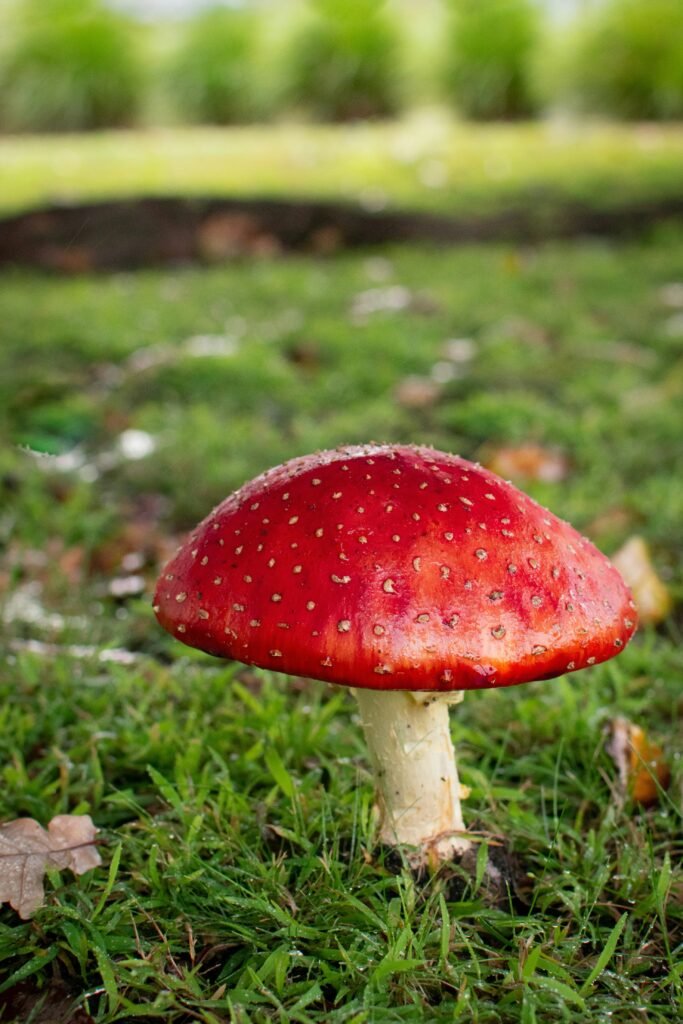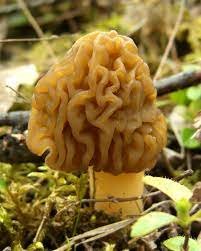Have you ever come across a mushroom in the wild that you weren’t sure about eating? Well, let us introduce you to Verpa Bohemica, a fascinating and delicious edible mushroom. In this article, we’ll provide you with an overview of Verpa Bohemica, exploring its appearance, habitat, and culinary uses. So next time you stumble upon this unique mushroom during a woodland stroll, you’ll know exactly what you’ve found and how to enjoy it in your next meal.

Taxonomy and Description
Family and Genus
Verpa bohemica belongs to the family Morchellaceae and the genus Verpa. The family Morchellaceae includes various species of edible and highly prized mushrooms. Verpa bohemica is commonly known as the “thimble morel” or “early morel.” It is closely related to other morel species, but it is distinct in its morphology and characteristics.
Physical Description
Verpa bohemica has a unique and recognizable physical appearance. Its cap is conical or bell-shaped, with a deep honeycomb-like structure on the surface. The cap can reach a height of 5-8 centimeters and a width of 3-5 centimeters. The color of the cap varies from light gray to grayish-brown. As the mushroom matures, the cap edges tend to curl upwards. The stem is smooth and slender, ranging from 5 to 10 centimeters in length. It is hollow and white, sometimes with a slightly yellowish tinge.
Similar Species
Verpa bohemica shares some similarities with other morel species, including Morchella esculenta and Morchella elata. However, there are distinct differences to look out for. Verpa bohemica has a cap that is more elongated and conical compared to the rounder cap of Morchella esculenta. Additionally, the honeycomb-like structure on Verpa bohemica’s cap is more pronounced and elongated. It is essential to correctly identify Verpa bohemica to avoid any confusion with toxic or poisonous species.
Habitat and Distribution
Preferred Habitat
Verpa bohemica can be found in a variety of habitats, including woodlands, meadows, and grassy areas. It prefers moist soil and is often found near trees such as ash, elm, poplar, and maple. This mushroom tends to appear early in the growing season, typically from late March to early May, depending on the geographical location. It is a saprophytic fungus, meaning it derives its nutrients from decaying organic matter.
Geographical Distribution
Verpa bohemica is distributed across various regions of North America and Europe. It has been recorded in countries such as the United States, Canada, Mexico, France, Germany, and the Czech Republic. Its wide distribution reflects its adaptability to different climatic conditions and habitats.
Seasonality
Verpa bohemica is considered an early season morel, often appearing before other morel species. In North America, it typically starts to emerge in late March or early April, depending on the weather and location. The seasonality can vary slightly in different regions, but it generally occurs during the spring.
Culinary Uses
Edibility
Verpa bohemica is edible and enjoyed by many mushroom enthusiasts. Its unique flavor and delicate texture make it a delightful addition to various culinary dishes. However, it is important to note that some individuals may have sensitivities or allergies to certain mushrooms, including Verpa bohemica. If you are unsure about your tolerance or reactions, it is advisable to consult a healthcare professional before consuming this mushroom.
Preparation Methods
Verpa bohemica can be prepared in numerous ways, depending on personal preference and culinary traditions. It is commonly sautéed, roasted, or used as an ingredient in soups, stews, and sauces. Some people enjoy breading and frying Verpa bohemica to create a crispy appetizer or side dish. The honeycomb-like structure of the cap tends to hold sauces and seasonings well, enhancing the flavor of the dish.
Flavor and Texture
Verpa bohemica possesses a delicate flavor profile that is often described as nutty, earthy, and slightly sweet. Its texture is tender and somewhat meaty, making it a versatile ingredient in various recipes. When properly cooked, Verpa bohemica retains its unique shape and enhances the overall taste of the dish.
Nutritional Profile
Macronutrients
Verpa bohemica is a low-calorie mushroom with a modest nutritional profile. It is primarily composed of water, with minimal fat and protein content. It is a good source of dietary fiber, which aids in digestion and promotes satiety.
Micronutrients
Verpa bohemica provides several essential vitamins and minerals, albeit in relatively small amounts. It contains notable levels of potassium, phosphorus, and magnesium. Additionally, it contains trace amounts of vitamins such as vitamin C and B vitamins, including niacin and riboflavin.
Health Benefits
While Verpa bohemica may not offer significant quantities of micronutrients, it can still contribute to a balanced diet. The dietary fiber present in this mushroom promotes healthy digestion and can support weight management efforts. Mushrooms, in general, are known for their potential immune-boosting properties and antioxidant activity. However, more research is needed specifically on the health benefits of Verpa bohemica.

Foraging and Identification
Tips for Foraging
When foraging for Verpa bohemica, it is important to exercise caution and ensure proper identification. Consider the following tips to enhance your foraging experience:
- Educate Yourself: Familiarize yourself with the physical characteristics of Verpa bohemica and its distinct features that differentiate it from toxic species. Refer to reliable field guides or seek guidance from experienced foragers.
- Observe the Habitat: Verpa bohemica prefers certain habitats, such as moist woodland areas near specific tree species. Keep an eye out for these preferred environments during the early spring foraging season.
- Check for Maturity: Ensure that the mushrooms you harvest are not overly mature or deteriorated. Younger specimens will be fresher and have better flavor and texture.
- Sustainable Harvesting: Only take what you need and avoid excessive harvesting. Leave some mushrooms behind to ensure their population and ecological role in the environment.
Identification Features
Verpa bohemica can be identified through its distinctive physical characteristics:
- Cone or bell-shaped cap with deep honeycomb-like ridges.
- Gray to grayish-brown coloration.
- Upward-curled cap edges as it matures.
- Slender, hollow stem that is white or slightly yellowish.
- Lacks true morel-like pits and ridges on the cap.
Take extra care to differentiate Verpa bohemica from toxic or poisonous look-alike species, such as Gyromitra esculenta, which can be fatal if consumed.
Confusion with Toxic Species
Verpa bohemica has a similar appearance to certain toxic species, specifically Gyromitra esculenta or “False Morel.” Gyromitra esculenta contains a compound called gyromitrin, which can be converted into a toxic substance called monomethylhydrazine (MMH). MMH can cause severe poisoning symptoms, including gastrointestinal distress and potential liver damage.
To avoid confusion, carefully assess the physical features of the mushroom and consult reliable resources or experienced foragers. It is crucial to differentiate Verpa bohemica’s elongated, honeycomb-like cap from the brain-like convolutions of Gyromitra esculenta. When in doubt, err on the side of caution and refrain from consuming any mushroom that is not positively identified as safe.
Harvesting and Storage
Harvesting Techniques
When harvesting Verpa bohemica, it is important to handle the mushrooms gently to avoid damage. Use a sharp knife or scissors to cut the stem close to the ground. It is advisable to carry a basket or mesh bag to allow spores to disperse as you continue foraging.
Cleaning and Processing
Once harvested, gently brush off any visible debris or soil from the mushrooms. Avoid washing Verpa bohemica, as it can absorb excess water and affect its texture. If necessary, use a damp cloth or paper towel to wipe off stubborn dirt. Remove any damaged or deteriorated parts before culinary preparation.
Storage Recommendations
The best way to store Verpa bohemica is to consume it fresh, as it tends to deteriorate relatively quickly. However, if you need to store it for a short period, place the mushrooms in a paper bag and keep them in the refrigerator’s vegetable drawer. Avoid tightly sealing the mushrooms in a plastic bag, as it can promote moisture buildup and lead to faster spoilage. Consume within a few days for the best quality and flavor.

Traditional and Medicinal Uses
Cultural Significance
Verpa bohemica holds cultural significance in certain culinary traditions and cuisines. It has been used in various traditional recipes, especially during the early spring foraging season. In some cultures, morel mushrooms are considered a delicacy and are highly sought after for their unique flavor and texture.
Medicinal Properties
While Verpa bohemica is primarily valued for its culinary uses, mushrooms, in general, have a long history of being used for their potential medicinal properties. However, specific research on the medicinal properties of Verpa bohemica is limited. It is essential to rely on well-established medicinal mushrooms and consult a healthcare professional before using mushrooms for medicinal purposes.
Historical Usage
Mushrooms have been utilized throughout history for their medicinal properties and nutritional value. Although specific historical usage records for Verpa bohemica may be limited, it is likely that early foragers and indigenous communities incorporated it into their diets and traditional medicines.
Research and Studies
Scientific Research
Scientific research on Verpa bohemica is relatively limited compared to other morel species. However, ongoing studies explore various aspects of its taxonomy, genetics, and ecology. Scientists continue to uncover the evolutionary relationships of Verpa bohemica within the larger Morchellaceae family, as well as its interactions with the surrounding environment.
Chemical Composition
The chemical composition of Verpa bohemica is still being studied to better understand its potential bioactive compounds and nutritional value. Traditional methods such as chromatography and spectral analysis help identify and characterize the unique chemical constituents present in this mushroom.
Biological Activity
Limited research suggests that Verpa bohemica, like other morel species, may possess bioactive compounds with potential antioxidant and antimicrobial properties. However, further studies are needed to establish the specific biological activities and potential therapeutic applications associated with this mushroom.

Conservation Status
Threats and Conservation Efforts
Verpa bohemica does not currently face significant conservation threats. However, it is important to practice responsible foraging and sustainable harvesting techniques to preserve the mushroom’s population and its natural habitats. Overharvesting or habitat destruction can have detrimental effects on mushroom populations and disrupt their ecological roles.
Protected Status
Verpa bohemica does not have any specific protected status. However, it is still crucial to respect nature and the ecosystems in which mushrooms grow. Adhere to local regulations and guidelines regarding foraging, especially in protected areas or conservation zones.
Significance in Ecosystems
As a saprophytic fungus, Verpa bohemica plays a vital role in the decomposition of organic matter in the ecosystem. It helps break down dead plant material, returning essential nutrients to the soil. Additionally, it contributes to the diversity of fungal species within its natural habitat.
Cautions and Considerations
Potential Risks
While Verpa bohemica is generally considered edible, it is important to remember that individuals may react differently to certain mushrooms. Some people may experience gastrointestinal discomfort or allergic reactions when consuming Verpa bohemica. If you are trying this mushroom for the first time, it is recommended to start with a small portion to gauge your tolerance.
Sensitivity and Allergies
Individuals with sensitivities or allergies to mushrooms should exercise caution when considering the consumption of Verpa bohemica or any other edible mushrooms. Allergic reactions can range from mild to severe, and it is advisable to consult a healthcare professional if you have any concerns.
Cooking Precautions
To maximize safety and reduce potential risks, it is important to cook Verpa bohemica thoroughly before consumption. Cooking helps break down any potentially harmful compounds and enhances the taste and texture. Avoid consuming raw mushrooms, as they may contain substances that are indigestible or irritants to the stomach.
In conclusion, Verpa bohemica, also known as the thimble morel or early morel, is an edible and distinctive mushroom that can be found in various parts of North America and Europe. Its unique physical characteristics, delicate flavor, and tender texture make it a prized ingredient in culinary preparations. However, it is crucial to properly identify Verpa bohemica and differentiate it from toxic look-alike species. Responsible foraging, sustainable harvesting practices, and cautious consumption are essential for enjoying this delicious mushroom safely.

